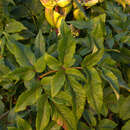Associations
provided by BioImages, the virtual fieldguide, UK
Foodplant / saprobe
ascoma of Acrospermum compressum is saprobic on dead stem of Angelica sylvestris
Foodplant / saprobe
perithecium of Arnium olerum is saprobic on old stalk of Angelica sylvestris
Foodplant / saprobe
sessile apothecium of Belonidium sulphureum is saprobic on dead stem of Angelica sylvestris
Remarks: season: 8-10
Foodplant / saprobe
gregarious, shortly stalked apothecium of Calycina herbarum is saprobic on dead stem of Angelica sylvestris
Remarks: season: 9-12
Foodplant / saprobe
apothecium of Crocicreas cyathoideum var. cyathoideum is saprobic on dead stem of Angelica sylvestris
Remarks: season: 3-10
Foodplant / miner
larva of Cryptaciura rotundiventris mines leaf of Angelica sylvestris
In Great Britain and/or Ireland:
Foodplant / saprobe
effuse colony of Cylindrotrichum dematiaceous anamorph of Cylindrotrichum oligospermum is saprobic on dead stem of Angelica sylvestris
Remarks: season: 4-9
Foodplant / saprobe
gregarious, often scarcely prominent pycnidium of Phomopsis coelomycetous anamorph of Diaporthopsis angelicae is saprobic on dead stem of Angelica sylvestris
Remarks: season: 7-4
Other: major host/prey
Foodplant / saprobe
effuse colony of Dictyosporium dematiaceous anamorph of Dictyosporium toruloides is saprobic on dead stem of Angelica sylvestris
Remarks: season: 1-12
Foodplant / parasite
cleistothecium of Erysiphe heraclei parasitises live Angelica sylvestris
Foodplant / miner
larva of Euleia heraclei mines live leaf of Angelica sylvestris
Foodplant / saprobe
Heteropatella anamorph of Heterosphaeria patella is saprobic on dead stem of Angelica sylvestris
Remarks: season: -9
Foodplant / saprobe
fruitbody of Lachnella alboviolascens is saprobic on dead stem (large) of Angelica sylvestris
Foodplant / saprobe
fruitbody of Lachnella villosa is saprobic on dead, decayed stem of Angelica sylvestris
Foodplant / saprobe
long stalked apothecium of Lachnum virgineum is saprobic on dead stem of Angelica sylvestris
Remarks: season: 2-8
Foodplant / saprobe
immersed, often becoming superficial pseudothecium of Leptosphaeria libanotis is saprobic on dead stem of Angelica sylvestris
Remarks: season: 5-9
Plant / resting place / within
ovum of Melanagromyza angeliciphaga may be found in hollow stem of Angelica sylvestris
Other: major host/prey
Foodplant / saprobe
at first immersed, later often erumpent pycnidium of Phoma coelomycetous anamorph of Metasphaeria complanata is saprobic on dead stem of Angelica sylvestris
Other: major host/prey
Foodplant / parasite
Mycosphaerella angelicae parasitises Angelica sylvestris
Foodplant / spot causer
hypophyllous colony of Cercosporidium dematiaceous anamorph of Passalora depressa causes spots on live leaf of Angelica sylvestris
Foodplant / open feeder
larva of Phaedon tumidulus grazes on live leaf of Angelica sylvestris
Remarks: season: -late 8
Other: uncertain
Foodplant / saprobe
linearly arranged pycnidium of Phomopsis coelomycetous anamorph of Phomopsis caulographa is saprobic on dead stem of Angelica sylvestris
Foodplant / spot causer
sterile, hypophyllous, grouped pycnidium of Phyllosticta coelomycetous anamorph of Phyllosticta angelicae causes spots on fading leaf of Angelica sylvestris
Remarks: season: 11
Foodplant / miner
larva of Phytomyza angelicae mines leaf of Angelica sylvestris
Other: sole host/prey
Foodplant / miner
larva of Phytomyza angelicastri mines leaf of Angelica sylvestris
Other: sole host/prey
Foodplant / spot causer
hypophyllous colony of sporangium of Plasmopara crustosa causes spots on live leaf of Angelica sylvestris
Foodplant / gall
embedded chlamydospore of Protomyces macrosporus causes gall of Angelica sylvestris
Remarks: season: 3-10
Foodplant / spot causer
colony of Pseudocercosporella anamorph of Pseudocercosporella pastinacae causes spots on live leaf of Angelica sylvestris
Foodplant / parasite
telium of Puccinia angelicae parasitises live Angelica sylvestris
Foodplant / parasite
pycnium of Puccinia bistortae parasitises Angelica sylvestris
Foodplant / saprobe
erumpent apothecium of Pyrenopeziza plicata is saprobic on dead stem of Angelica sylvestris
Remarks: season: 5-11
Foodplant / spot causer
mostly hypophyllous colony of Ramularia hyphomycetous anamorph of Ramularia archangelicae causes spots on live leaf of Angelica sylvestris
Foodplant / saprobe
subepidermal, black pycnidium of Rhabdospora coelomycetous anamorph of Rhabdospora pleosporoides var. rubsecens is saprobic on dead, reddish-spotted stem of Angelica sylvestris
Remarks: season: 5
Foodplant / saprobe
colony of Stachybotrys dematiaceous anamorph of Stachybotrys dichroa is saprobic on dead stem of Angelica sylvestris
Remarks: season: 4-9
Foodplant / pathogen
synnema of Symphyosira anamorph of Symphyosirinia angelicae infects and damages fallen, previous year's, buried under marsh vegetation mericarp of Angelica sylvestris
Remarks: season: -12
Foodplant / saprobe
fruitbody of Typhula uncialis is saprobic on dead, decaying stem of Angelica sylvestris
Remarks: season: spring-summer
Other: minor host/prey
Comments
provided by eFloras
The roots have reputed medicinal properties.
- license
- cc-by-nc-sa-3.0
- copyright
- Missouri Botanical Garden, 4344 Shaw Boulevard, St. Louis, MO, 63110 USA
Description
provided by eFloras
Plants perennial, 0.8–2 m. Root conic, thick, slightly aromatic. Stem 1–2.5 cm thick, ribbed, pubescent below umbel. Basal and lower leaves petiolate, petioles long, sheaths ovate to saccate-inflated; blade broadly triangular-ovate, 2–3-pinnate; leaflets sessile, lanceolate to ovate, 2.5–8 × 1–4 cm, base cuneate, margin serrulate, slightly hispidulous along nerves. Umbels 10–20 cm across; bracts absent or 1–2, linear, deciduous; rays 15–30, pubescent; bracteoles many, linear, as long as pedicels. Calyx teeth obsolete. Petals white, ovate to obovate. Fruit broad-ovoid, 5–6 × 3.5–5 mm; dorsal ribs filiform, lateral ribs winged; vittae 1 in each furrow, 2 on commissure. Fl. Jun–Jul, fr. Aug–Sep. n = 11*.
- license
- cc-by-nc-sa-3.0
- copyright
- Missouri Botanical Garden, 4344 Shaw Boulevard, St. Louis, MO, 63110 USA
Distribution
provided by eFloras
Xinjiang [Russia (Siberia); C and N Europe].
- license
- cc-by-nc-sa-3.0
- copyright
- Missouri Botanical Garden, 4344 Shaw Boulevard, St. Louis, MO, 63110 USA
Habitat
provided by eFloras
Forest margins, damp grasslands, marshy areas, river banks; 900–1100 m.
- license
- cc-by-nc-sa-3.0
- copyright
- Missouri Botanical Garden, 4344 Shaw Boulevard, St. Louis, MO, 63110 USA
Angelica sylvestris: Brief Summary
provided by wikipedia EN
Angelica sylvestris or wild angelica is a species of flowering plant, native to Europe and central Asia. An annual or short-lived perennial growing to a maximum of 2.5 metres (8.2 ft), it has erect purplish stems and rounded umbels of minuscule white or pale pink flowers in late summer.
- license
- cc-by-sa-3.0
- copyright
- Wikipedia authors and editors

